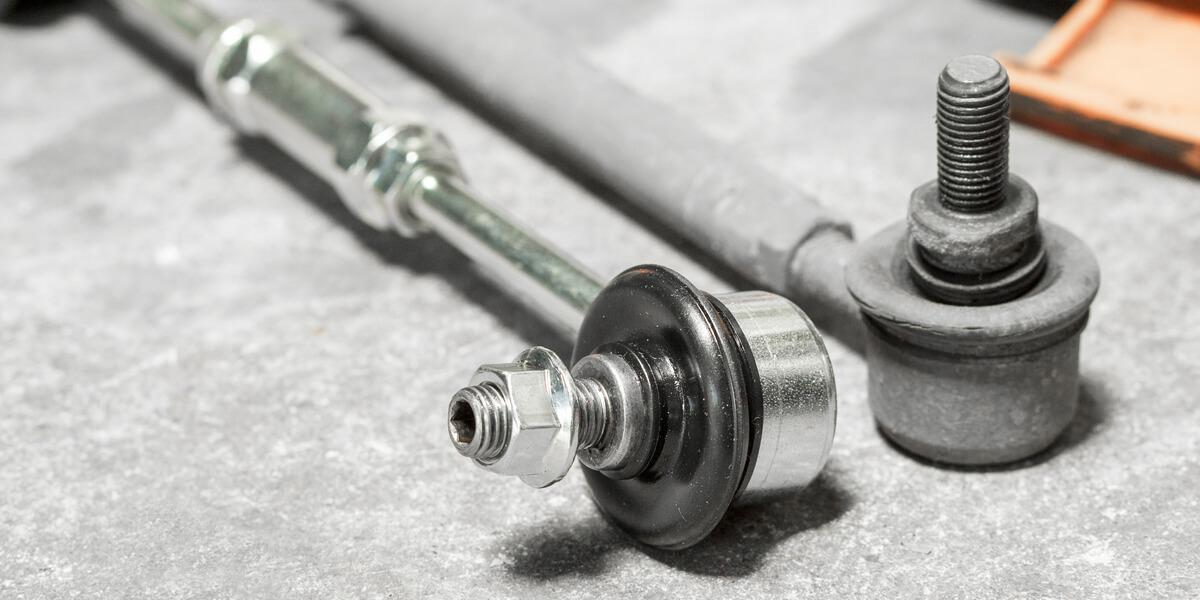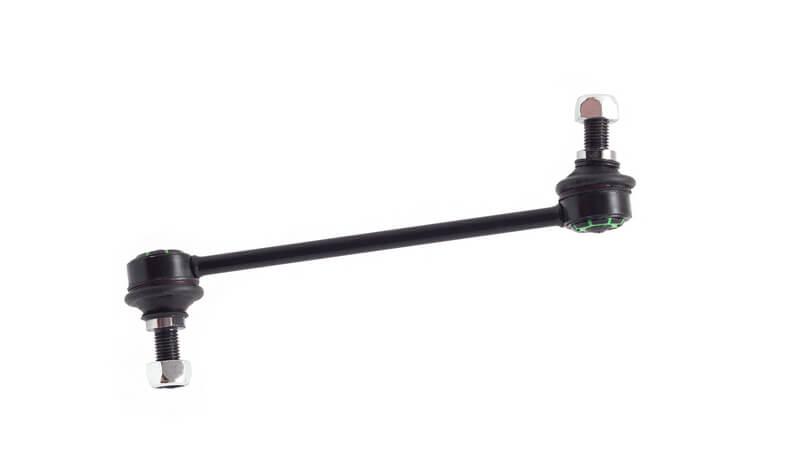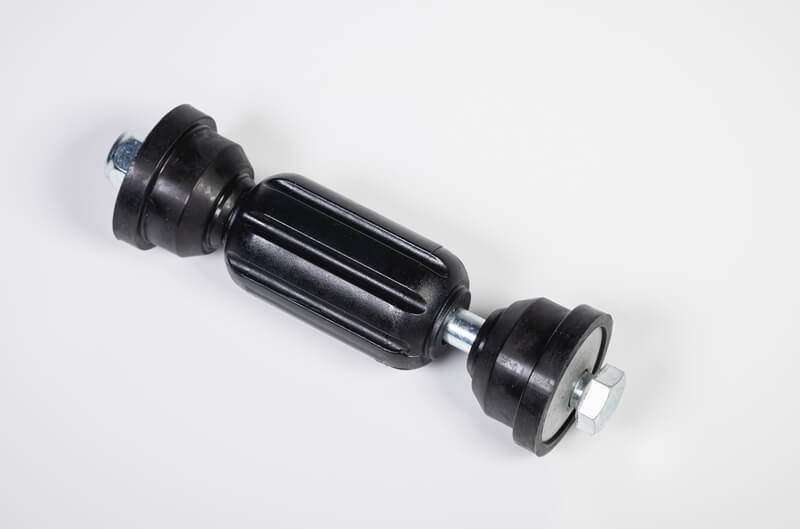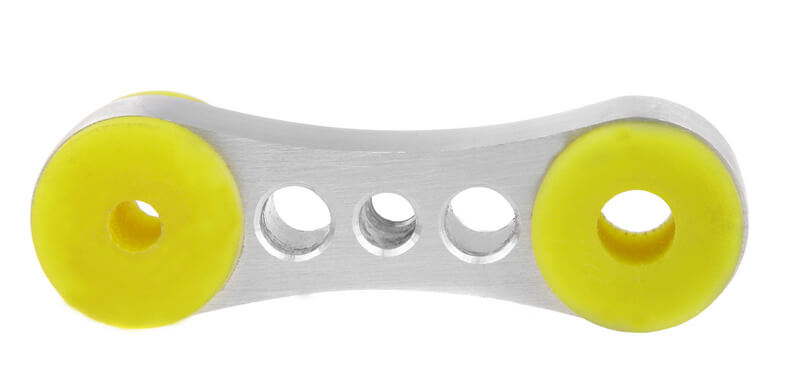
Before we proceed with a thorough explanation of sway bar links and all there is to know about them, let's first focus on the sway bar itself to understand their purpose and position within the suspension setup. A sway bar (also called an anti-roll bar or stabilizer bar) is part of the suspension system, helping to reduce unwanted body roll. Generally, a U-shaped steel bar, the sway bar connects opposite wheels and forces each side of the vehicle to adapt to the other in a sharp turn.
When your car faces a sharp turn, most of its weight shifts to the outer side, and inside wheels might lift, and their suspension will compress. The anti-roll bar will follow the outer wheels and use the torque generated by their movement to lower the inside wheels, keeping the car balanced and level. Sway bars can also be used to increase/decrease oversteer and understeer, thus changing the way the vehicle behaves in turns.
Now, sway bar links connect the sway bar's ends with another suspension component, usually the lower control arm. The sway bar's other connecting points are usually the sub-frame of the vehicle, and this is where sway bar bushings enter the fray.
See also: Sway Bar| What It Is It and What Does It Do
What Are Sway Bar Links?
As already mentioned, sway bar, anti-roll bar, or stabilizer bar links serve as an attachment point between the actual sway bar and different parts of the vehicle suspension. Sway bar links that connect the sway bar with another suspension member (usually strut or control arm) on both sides of the vehicle are also called sway bar end links.
 Links with some type of ball joints at each end are the most common ones.
Links with some type of ball joints at each end are the most common ones.What do Sway Bar Links do?
Links not only connect the sway bar with the suspension but force the sway bar to move and flex to even out the vehicle's weight distribution. When the outside wheel or suspension component gets pushed downward in turn, the sway bar link follows suit and applies torsion to the sway bar itself. This, in turn, applies torsion to the link on the other side of the sway bar, causing the other wheel or its suspension component to react accordingly.
Different Types of Links
There are several different types of sway bar links, but here are some of the most common examples.
- Bolt & bushing - nowadays, this is considered an outdated type of sway bar end links typically found on older vehicles. It consists of a bolt with retainers and bushings that are all separate pieces.
- Ball-joint - commonly found in modern vehicles, they consist of a single-piece bolt with ball and socket joints on either end.
- Fixed bushing - consists of a single-piece bolt with bushings on either end. They're attached using bolts.
- Adjustable length - the most advanced type of sway bar links consists of a single-piece body with ball ends on each side. As their name suggests, they feature adjustable length, which allows the tuning of sway bar pre-load and accommodates lifting or lowering your vehicle.
Bad Sway Bar Links Symptoms
Although the sway bar itself is usually made of high-grade steel and is quite durable, the sway bar links, on the other hand, aren't. Like most car parts incorporating some call of ball joints, they tend to wear out over time. Some of them will wear out sooner, while others may last a little longer, depending on the type and material they're made from.
When a sway link gets worn out, it will start to exhibit easily recognizable symptoms like a knocking noise coming from the suspension when driving slowly over potholes or road bumps. It may creak and squeak when the suspension moves up and down. Such a condition is frequently due to the dried up grease inside the ball joint at either end of the link. Ignoring these symptoms for too long, and the rusty, worn out sway bar link will eventually pop out of its joint.
 Bolt & bushing type.
Bolt & bushing type.Can You Drive With Bad Sway Bar Links?
Technically, yes. As far as the vehicle's mobility is concerned, bad sway bar links won't stand in your way. Your car will still ride without any issues, but its handling and cornering abilities will be altered to such an extent that a broken anti-roll bar link may compromise your safety at some point. To avoid undesired effects and premature wear on the other suspension components or even unwanted safety hazards, always replace worn-out sway bar links as soon as possible.
How to Replace Sway Bar Links?
Replacing links is one of the most straightforward jobs as far as car maintenance, and part replacements go. Although various types of links feature different end sides, don't let that confuse you. The process is mostly similar regardless of the link type.
For starters, raise and support your vehicle. Although it's not always necessary to remove the wheels, doing so will give you more room to operate.
Ball-joint type
The next part is to remove the old links. If it's an older style link that hasn't been replaced in a while, rust may make the removal process slightly more complicated. In that case, it's best to cut the bolts using a grinding wheel. Otherwise, use a ratchet and socket on the lower nut and a wrench on the upper one. For fixed bushing and ball-joint sway bar links, simply remove the nuts holding them. Finally, remove the old sway bar link and install the new one in reverse order.
Bolt & bushing type
While installing an old type bolt & bushing sway bar link, pay attention to place the washer on the bolt with the cup facing the threads and then place the first of four bushings with its lip also facing the threads. Slide the bolt down through the end of the sway bar and repeat the process with the second bolt and washer, but in reverse order and opposite direction. Slide the spacer onto the bolt and place the third pair of washers and bushings (facing the lower control arm) before threading the bolt through the control arm. Finally, apply the last bushing/washer set onto the bolt below the control arm and tighten the end link just until the bushings begin to compress.
Adjustable type
Replacing adjustable sway bar links begins with adjusting your new link with the old one. Screw/unscrew the new link until it fits the original part's length. The remainder of the process is the same. Remove the upper and lower nuts, take out the old link, and install the new one. Leave the locking nuts on both ends loose because adjustable links have to be adjusted at a neutral static height. In other words, while the car is firmly on the ground. After lowering the vehicle, make sure that the ball is at the 90-degree angle to the pin. Finally, lock the sway bar end link using two spanners.
When in doubt, make sure to get your hands on your car's repair manual so you can follow the manufacturer's recommended procedure.
 Fixed bushing type.
Fixed bushing type.Cost to Replace Sway Bar Links
Luckily, sway bar links are some of the cheapest and easiest components to replace. A set of sway bar links usually costs between $15 and $50 depending on the make and type. This is pretty much the cost of DIY sway bar link replacement. The simplest of stabilizer bar links shouldn't take more than 15 minutes per unit to replace with proper tools.
The cost to replace sway bar links rises considerably if you opt to let professionals take care of it. An independent repair shop will usually charge 30 min per link for a total of an hour of work. Depending on your repair shop's hourly rate, replacing two links should cost between $75 and $150 in labor.
Of course, there's also a price discrepancy between OEM and aftermarket sway bar links, but it isn't that significant. Basic aftermarket links should be just fine for most drivers. However, adjustable units can improve your car's handling depending on their quality. However, keep in mind that they'll also probably stiffen up your ride. Adjustable links often come with stiffer polyurethane bushings as opposed to soft OEM's rubber bushings.
Frequently Asked Questions (FAQ)
What happens if sway bar links break while driving?
If a sway bar link breaks while you're driving, you might notice increased body roll and a shift in how your vehicle handles around corners. While you can still drive, it's not ideal since the car becomes more unstable, especially during turns, making it a potential safety hazard.
How long do sway bar links usually last?
The lifespan of sway bar links varies based on the vehicle, driving conditions, and the type of sway bar links you have. Generally, they should last anywhere between 50,000 to 100,000 miles, but regularly driving on rough roads can reduce their longevity.
Can I replace sway bar links myself?
Absolutely! Replacing sway bar links is a relatively simple DIY job for those comfortable working on cars. With some basic tools and a little patience, you can tackle the job in under an hour. Just make sure to follow your car's repair manual for the correct steps.
How do I know if my sway bar links need replacing?
Some common signs include clunking or rattling noises when driving over bumps or uneven surfaces, noticeable body roll during cornering, or even a squeaky suspension. If you're experiencing any of these symptoms, it's time to inspect your sway bar links.
Do upgraded sway bar links improve performance?
Yes, upgraded sway bar links, particularly adjustable ones with stiffer bushings, can improve your vehicle's handling by reducing body roll. However, be aware that stiffer links might also lead to a harsher ride, so it’s a trade-off depending on your priorities.
Replacing Sway Bar Links — Should You Do It?
Sway bar links might not be the most critical part of your suspension system, but ignoring faulty ones could cost you more than you expect in the long run. Sure, your car will still drive with worn or broken sway bar links, but what you're trading for that mobility is handling precision and, potentially, the safety of your suspension system as a whole. When those links wear out, your vehicle’s stability suffers—especially at high speeds or during sharp cornering. And the longer you drive with bad links, the more stress you put on other suspension components, leading to expensive repairs that could’ve been avoided.
The good news is that sway bar links are affordable and easy to replace, making it a no-brainer to address them sooner rather than later. Don’t wait until it’s too late—keep those links in check and swap them out when needed to ensure your ride stays safe and smooth.
